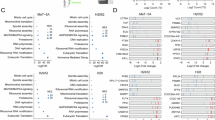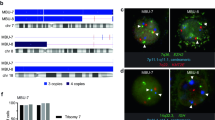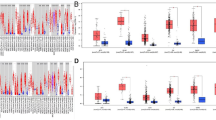Abstract
Tumorigenesis is a multi-step process involving a series of changes of cellular genes. Most solid tumors and hematopoietic malignancies often show abnormal chromosome numbers, the aneuploidy. The chromosomal aneuploidy keeps cells in the state of chromosomal instability (CIN) that will increase the mutation rate of cells affected and thus push them deeper into the process of tumorigenesis. The yeast genetic studies showed that normal distribution of chromosome during mitosis is under the surveillance of a set of genes, the spindle assembly checkpoint genes, that include the BUB and MAD gene groups and MPS. In some colorectal cancers with CIN it was found to have hBUB1 gene mutated and the mutated gene functions dominantly. We have examined a series of breast cancer cell lines with or without CIN for the hBUB1 gene mutation and found none. However, we detected various degrees of deletion in the coding sequences of the hBUB1 gene in cells from T lymphoblastic leukemia cell lines, Molt3 and Molt4, and cells from some acute lymphoblastic leukemia and Hodgkin's lymphoma patients. So far the lesions of deletion are in the kinetochore localization domain of the hBUB1 gene that may explain why the deletion lesions in the BUB1 gene cause aneuploidy in lymphoma and lymphoma cells. The deletions are heterozygous in nature. Like the mutated hBUB1 gene in colorectal cancer, the mutant hBUB1 cDNA from lymphoblastic leukemia cells behaves dominantly.
This is a preview of subscription content, access via your institution
Access options
Subscribe to this journal
Receive 50 print issues and online access
$259.00 per year
only $5.18 per issue
Buy this article
- Purchase on SpringerLink
- Instant access to full article PDF
Prices may be subject to local taxes which are calculated during checkout










Similar content being viewed by others
References
Cahill DP, da Costa LT, Carson-Walter EB, Kinzler KW, Volgelstein B, Lengauer C . 1999 Genomics 58: 181–187
Cahill DP, Lengauer C, Yu J, Riggins GJ, Willson JK, Markowitz SD, Kinzler KW, Vogelstein B . 1998 Nature 392: 300–303
Elledge SJ . 1996 Science 274: 1664–1672
Hartwell L . 1992 Cell 71: 543–546
Hoyt MA, Stearns T, Botstein D . 1990 Mol. Cell. Biol. 10: 223–234
Hoyt MA, Totis L, Roberts BT . 1991 Cell 66: 507–517
Lengauer C, Kinzler KW, Vogelstein B . 1997 Nature 386: 623–627
Lengauer C, Kinzler KW, Vogelstein B . 1998 Nature 396: 634–649
Li R, Murray AW . 1991 Cell 66: 519–531
Li Y, Benezra R . 1996 Science 274: 246–248
Loeb LA . 1991 Cancer Res. 51: 3075–3079
Murray AW . 1995 Curr. Opin. Genet. Dev. 5: 5–11
Nasmyth K . 1996 Trends Genet. 12: 405–412
Scolnick DM, Halazonetis TD . 2000 Nature 406: 430–435
Taylor SS, Mckeon F . 1997 Cell 89: 727–735
Vogelstein B, Kinzler KW . 1994 Cold Spring Harbor Symp. Quan. Biol. LIX: 517–521
Acknowledgements
We would like to thank Dr Dan Cahill for providing the genomic sequence information on the hBUB1 locus. The comments and suggestions by Dr Y-L Juang were very helpful in carrying out these experiments. We also appreciate the suggestions from the anonymous reviewer for hBUB1 localization and binding assay that have improved the manuscript. PL Chen, CS Ho, YZ Chen, and SS Wei participated in the early phase of this work. We appreciated the technical assistance of YS Kuo. This work is supported by a grant from the National Science Council (NSC89-2320-B-320-017) and by Teu Chi Foundation.
Author information
Authors and Affiliations
Corresponding author
Rights and permissions
About this article
Cite this article
Ru, H., Chen, R., Lu, W. et al. hBUB1 defects in leukemia and lymphoma cells. Oncogene 21, 4673–4679 (2002). https://doi.org/10.1038/sj.onc.1205585
Received:
Revised:
Accepted:
Published:
Issue date:
DOI: https://doi.org/10.1038/sj.onc.1205585
Keywords
This article is cited by
-
Expression of the checkpoint kinase BUB1 is a predictor of response to cancer therapies
Scientific Reports (2024)
-
Chromosome integrity checkpoints in stem and progenitor cells: transitions upon differentiation, pathogenesis, and aging
Cellular and Molecular Life Sciences (2018)
-
BUB3 that dissociates from BUB1 activates caspase-independent mitotic death (CIMD)
Cell Death & Differentiation (2010)
-
The molecular basis of genistein-induced mitotic arrest and exit of self-renewal in embryonal carcinoma and primary cancer cell lines
BMC Medical Genomics (2008)
-
Spindle checkpoint protein Bub1 corrects mitotic aberrancy induced by human T-cell leukemia virus type I Tax
Oncogene (2006)



